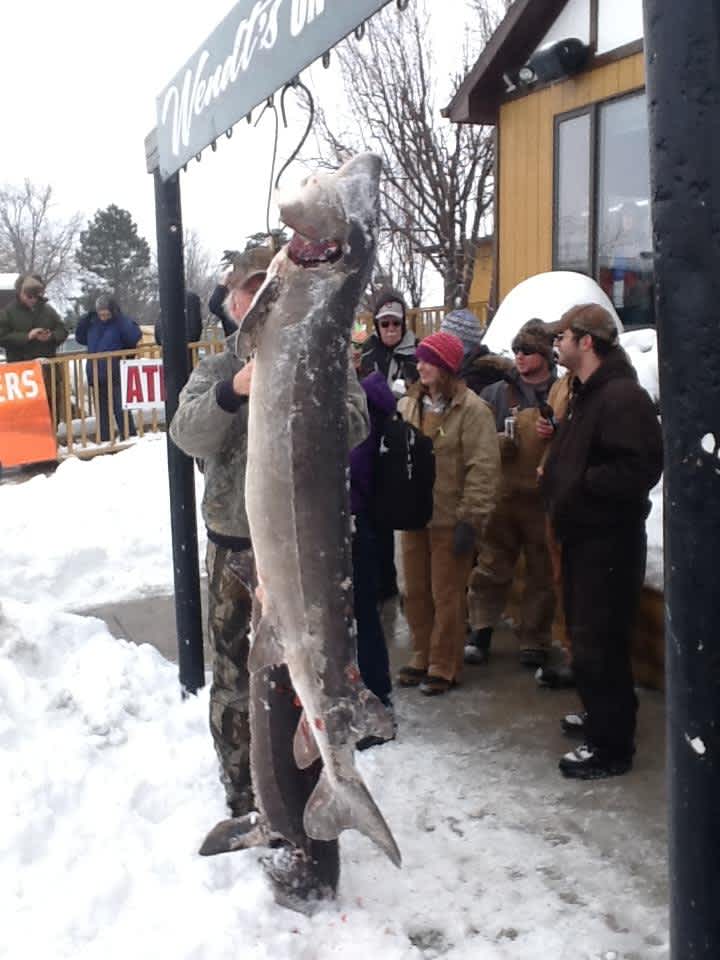Cheese Hats to Sturgeon Hats: Spear Fishing on Lake Winnebago
K.J. Houtman 02.11.13


The destination was Lake Winnebago—Fond du Lac, Wisconsin. I found myself amongst many a Packer backer over the weekend, though they showed a different season’s obsession. Their focus moved from the neighboring Monsters of the Midway just long enough to take aim at a different monster, a nearly prehistoric and huge fish: the lake sturgeon. No hook, line and sinkers; this is spearing season and I had two days on my calendar to give it a try. Locals fondly call the sturgeon “dinosaurs.” After you see one you will understand why.
First of all, I ordered my sturgeon spearing tag back in the fall. The deadline is the last day of October. One needs planning and organization to participate in this sport.
Secondly, you need to book your shanty rental while the gettin’ is good—the sooner the better. We worked with one of the best on Lake Winnebago: Wendt’s Marine and Wendt’s on the Lake Restaurant in Van Dyne on the Southwest corner of the lake. Nice folks with first-class service.
I arrived early to see the ice preparation up close and personal. No ordinary auger cuts spearing holes, oh no! The opening needed is akin to a small conference room table: 3’ x 6’. A very long chainsaw is the equipment, held at an angle to smooth out sharp edges. Each spearing shanty has one or two holes.
I quickly learned to get out of the way of the cutting as water sprayed ten feet behind the chainsaws. Three to four people used wooden sticks over six feet long to tuck the floating ice slab (known as the cake) back under the ice. Then experts at Wendt’s strategically aligned the shanty over the open holes.
Time to wait until morning. The season would open at 6:30 a.m.
Driving through a little fog, we arrived at our shanty on schedule. We didn’t want to miss a minute of legal time to spear—a short six-hour window is allowed each day. It took a while for my eyes to adjust to the darkness inside. Black walls and a black ceiling forced attention to one place: the cut hole. A propane-powered heater kept it comfortable inside.
Two spears hung from hooks on beams across the ceiling, each above a hole with tines in the water. I lifted one to see how it felt. It was very heavy and nearly seven feet long. If one is fortunate enough to spear a sturgeon, the spear handle pops off and anglers use old-fashioned, hand-over-hand retrieval by rope.

Sturgeon are curious old fish. Best practice dictates suspending a decoy to entice them to your exact spot. Truthfully, I don’t know if it works. But I can imagine a very wise and experienced angler long ago decided it was necessary to have something to stare at for six hours day after day.
Our decoy was the shape of a fish. I know…yawn. I heard stories of unique decoys like toilet seats, copper gelatin pans, or minnows closed tightly inside a sealed pickle jar. The best-sounding decoy? A disco ball. Lights are illegal but I can imagine a disco ball would illuminate natural daylight (through the ice) pretty darn well. Note to self for next year!
PVC tubing in the shape of an “X” on the lake bottom helped identify a target zone and any movement into it. Other than a few shad and small perch fingerlings, our boring fish decoy was the only thing I saw until 12:30 p.m. both days. Check that. Often my eyes would play tricks on me. Black shadows the same size of the decoy would appear just a few feet in front of it or behind it. I did a double-take. Nope, just my imagination. Maybe my subconscious was trying to fill in what it wanted to see. Only my imagination was too small—way, too small.Thirty-nine sturgeon were taken the first day and 21 the second on Lake Winnebago. The estimated population is just over 50,000 resident fish. The largest sturgeon weighed 179 pounds in the first two days. The one pictured here was the heaviest at Wendt’s tagging station: about 110 pounds. The season runs through February 24, 2013 or closes early when harvest limits are reached. Over 2,700 shanties graced the ice the first day, a few less the second day.
For those that speared their fish the excitement was palpable. In a festival-like atmosphere, folks came from many miles around to watch the “dinosaurs” get weighed-in and displayed.

And children donned their sturgeon hats.
What a tremendous ritual—rich in history and love of nature and conservation. Local biologists working hand-in-hand with fishing clubs and avid anglers in the region have made today’s sturgeon population robust and healthy. Many of the same people that spear sturgeon in February guard them in twelve-hour shifts during the spring spawn to prevent their theft from easy-access river edges. They do it to protect their eggs. They do it to protect their future.
The sturgeon is an amazing fish, unchanged physically for over 75 million years. Their healthy population, in Wisconsin and elsewhere around the world, has come from the hard work and lessons learned by the passionate anglers of the Lake Winnebago area.
Year one for me? Good times for sure, but more staring than spearing. I hope to get one next year—count me in. Now…where’s my new hat?
Editor’s note: The Fond du Lac Convention and Visitor’s Bureau graciously hosted the first Women on Winnebago (WOW) media event on the lake this year. K.J. Houtman was one of the many special guests honored to be a part of the gathering.
K.J. Houtman is author of the award-winning Fish On Kids Books series, chapter books for 8-12 year olds with adventures based around fishing, camping, and hunting. Available at Amazon and local bookstores. Find out more at fishonkidsbooks.com.

